Earth Sciences in Tuscany

Since the Middle Ages, Tuscany has been a region favoured by scholars of natural phenomena for her complex morphology. Already at the end of the 13th century, the monk Ristoro d’Arezzo explored the territory in search of stones, minerals and petrified shells, recognising the marine nature of fossils, which he and many other scholars of the following centuries thought to be the remains of the Great Flood. Leonardo da Vinci was the first to understand the origin of marine fossils.
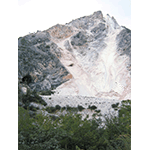
The Mineral Wealth of Tuscany
The region’s wealth owes to the mines and quarries scattered over the territory. Lead, silver and iron, copper and zinc were extracted at the mines of Monterotondo, Elba Island, the territory of Volterra, the State of Siena and Pietrasanta. The alum mines of Volterra were of great importance. This substance necessary to dye wool and also used in medicine for its astringent properties, drove Lorenzo the Magnificent to wage war against Volterra, precisely to gain control of the Sasso alum mines. Renowned then, as they still are today, the Apuane quarries supplied the great artists of the Renaissance, Michelangelo first among them, with spotless marble.
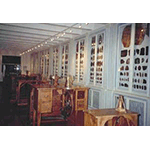
The Art of Metals and the Allure of Stones
Vannoccio Biringuccio from Siena, mineralogist, chemist and engineer, in the service of the Republic of Florence and author of La pirotechnia, was an expert of Tuscan mines. In 1563, Florentine Michelangelo Florio translated the famous treatise De re metallica by Giorgio Agricola "into the Tuscan language".
The Medicis, starting with Cosimo I, exploited the excellent economic potentials of the region’s mines. The attention of the reigning house turned to every product of the earth. In 1597, Dominican friar Agostino del Ricco wrote L’Istoria delle pietre, a document of the experimental culture promoted by Francesco I and Ferdinando I de’ Medici. Indeed, in those same years, the grand-ducal collections grew and the chapels of noble families were embellished with precious stones.
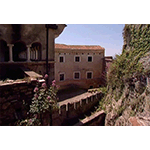
Collection Minerals
In the 16th century, botanical gardens were venues where earth sciences were taught; in Pisa, Luca Ghini commented the De mineralibus by Dioscorides, and Andrea Cesalpino published the De metallicis. By order of Grand Duke Ferdinando I, a Gallery of natural finds, destined to students and lecturers of the University, was adjoined to the Botanical Garden of Pisa. A document dated 1591 reports that a collection of minerals from the mines of Pietrasanta was placed in "certain cabinets with wiring, so that the students can see them but not carry them off".
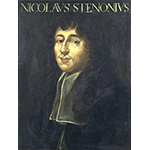
Niccolò Stenone and the Earliest Stage of Geology
Until the middle of the 17th century, it was believed that the morphology of the Earth derived from the Great Flood and that every "petrified" remain was produced by the Earth itself. In 1667, the year after he had moved to the grand-ducal court, Danish scientist Niccolò Stenone published in Florence a report on the anatomical examination of a shark’s head fished in Livorno and sent to the scientist by Grand Duke Ferdinando II. In his brief report, Stenone refers to the so-called "glossopteris" as organic remains. These "stone tongues", similar to shark teeth were believed to be a miraculous product of the earth and, as such, were sought after by pharmacists and collectors. Through the study of the fossil and mineral finds from every part of the Grand Duchy destined to the Medici collections, Stenone confronted the stratigraphic problems tied to the formation of fossils even more thoroughly, and confirmed their organic origin. We are at the dawn of modern geology.
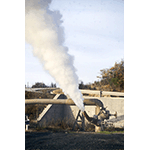
Geology in the 18th Century
The lively scientific debate of the 18th century favoured the birth of new disciplines, such as geology and palaeontology. Antonio Vallisneri from Garfagnana, a teacher in Padua, observed that springs did not originate from sea water pushed up from below, but instead gushed forth by filtration from above. Between 1753 and 1757, Venetian metallurgist Giovanni Arduino was in Tuscany, instructed by a mining company of Livorno to conduct investigations and fusions in several mines on Sienese territory. In the late seventies, Hubert Hoefer from Germany and Paolo Mascagni observed the presence of boric acid or "sedative salt" in the water of the "lagoni" of Volterra: shortly thereafter began the industrial exploitation of the borax fumaroles. The natural science studies conducted by Pier Antonio Micheli and Giovanni Targioni Tozzetti were at the basis of a greater knowledge of the resources and morphology of the subsoil. As early as 1733, Pier Antonio Micheli affirmed the volcanic origin of Mount Amiata. His acute observations were picked up by his student Giovanni Targioni Tozzetti, author of a thorough naturalist-antiquarian exploration of the Grand Duchy.
The "Pisan Geological School"
Giorgio Santi was a leading figure in the ambit of geological research, an untiring traveller and author of Viaggi per la Toscana, also translated into French. He was director of the Botanical Garden of Pisa as of 1782 and, as of 1810, holder of the chair in zoology, mineralogy and geology (finally separated from the chair of botany) at the University of Pisa. These were the years that preluded the "Pisan geological school", one of the principal episodes in the development of earth sciences in Italy. Its creator was Paolo Savi, a great geologist and zoologist, son of botanist Gaetano Savi. In addition to Savi, members were also Giuseppe Meneghini and Leopoldo Pilla who was summoned to fill the new chair in geology and mineralogy at the University of Pisa in 1842.
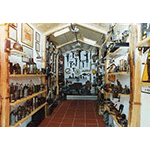
Present Mineralogical Museums
The mineral wealth of Tuscany is documented by analysis on the territory, as well as by the rich network of museum institutions: from the Civic Museum of Natural Sciences and Archaeology of Valdinievole to the Ethnographic Historical Museum of Miners and Quarrymen in Pescia; from the Museum of Natural History and the Territory in Calci to the mineralogy section of the Museum of Natural History of Florence; from the Centre of Natural Sciences of Galceti in Prato to the Mineral Museum of Campiglia Marittima; from the Museum of Mineralogy and Geology of Giglio Island to the two Mine Museums of Massa Marittima, up to the Mineral Museums of Elba Island. Also of great interest are the numerous parks scattered over the territory, which include the Mineral Park of Elba Island, the San Silvestro Archaeological Mines Park, the Gavorrano Natural Mining Park, the Mining Museum Park of Abbadia San Salvatore, and the territorial circuit which includes the Mine Museum of Montecatini Val di Cecina. Finally, in addition to the modern initiatives of mineral collection, such as that of the Mineralogical Group of Fornaci di Barga, we wish to recall the numerous historical collections belonging to school institutions.
-
 Centro di Scienze Naturali di Galceti [Galceti Natural Science Centre]
Centro di Scienze Naturali di Galceti [Galceti Natural Science Centre] -
 Gruppo Mineralogico e Paleontologico di Fornaci di Barga [Mineralogical and Palaeontological Group of Fornaci di Barga]
Gruppo Mineralogico e Paleontologico di Fornaci di Barga [Mineralogical and Palaeontological Group of Fornaci di Barga] -
 Museo Civico di Scienze Naturali e Archeologia della Valdinievole [Valdinievole Civic Museum of Natural Science and Archaeology]
Museo Civico di Scienze Naturali e Archeologia della Valdinievole [Valdinievole Civic Museum of Natural Science and Archaeology] -
 Museo dei Minerali Elbani 'Alfeo Ricci' ['Alfeo Ricci' Museum of Elban Minerals]
Museo dei Minerali Elbani 'Alfeo Ricci' ['Alfeo Ricci' Museum of Elban Minerals] -
 Museo del Minerale [Mineral Museum]
Museo del Minerale [Mineral Museum] -
 Museo della Mineralogia e della Geologia dell'Isola del Giglio [Mineralogical and Geological Museum of Giglio Island]
Museo della Mineralogia e della Geologia dell'Isola del Giglio [Mineralogical and Geological Museum of Giglio Island] -
 Museo della Miniera [Mining Museum]
Museo della Miniera [Mining Museum] -
 Museo delle Miniere di Montecatini [Mine Museum of Montecatini]
Museo delle Miniere di Montecatini [Mine Museum of Montecatini] -
 Museo di Arte e Storia delle Miniere [Museum of Mining Art and History]
Museo di Arte e Storia delle Miniere [Museum of Mining Art and History] -
 Museo di Storia Naturale di Firenze - Sezione di Mineralogia e Litologia [Florence Museum of Natural History - Mineralogy Section]
Museo di Storia Naturale di Firenze - Sezione di Mineralogia e Litologia [Florence Museum of Natural History - Mineralogy Section] -
 Museo di Storia Naturale e del Territorio di Calci [Museum of Natural History and of the Calci Territory]
Museo di Storia Naturale e del Territorio di Calci [Museum of Natural History and of the Calci Territory] -
 Museo 'I Minerali Elbani della Gente di Rio' ['The Elban Minerals of the People of Rio' Museum]
Museo 'I Minerali Elbani della Gente di Rio' ['The Elban Minerals of the People of Rio' Museum] -
 Museo Storico Etnografico del Minatore e del Cavatore [Ethnographic Historical Museum of Miners and Quarrymen]
Museo Storico Etnografico del Minatore e del Cavatore [Ethnographic Historical Museum of Miners and Quarrymen] -
 Parco Archeominerario di San Silvestro [San Silvestro Archaeological Mines Park]
Parco Archeominerario di San Silvestro [San Silvestro Archaeological Mines Park] -
 Parco Minerario dell'Isola d'Elba - Museo dei Minerali dell'Elba e dell'Arte Mineraria [Mineral Park of Elba Island - Mineral Museum of Elba and of the Mining Art]
Parco Minerario dell'Isola d'Elba - Museo dei Minerali dell'Elba e dell'Arte Mineraria [Mineral Park of Elba Island - Mineral Museum of Elba and of the Mining Art] -
 Parco Minerario Naturalistico di Gavorrano [Gavorrano Natural Mining Park]
Parco Minerario Naturalistico di Gavorrano [Gavorrano Natural Mining Park] -
 Parco Museo Minerario [Mining Museum Park]
Parco Museo Minerario [Mining Museum Park]
****************************
Texts by Alessandro Tosi
English translation by Victor Beard
Last update 03/gen/2008


